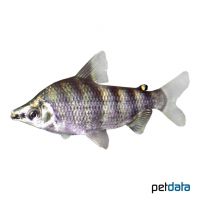Marbled Headstander (Abramites hypselonotus)
| Marbled Headstander Abramites hypselonotus | |
|---|---|
| Name | Marbled Headstander |
| Name Lat. | Abramites hypselonotus |
| Synonym | Leporinus hypselonotus |
| Family | Headstanders |
| Family lat. | Anostomidae |
| Order | Characins |
| Order lat. | Characiformes |
| Origin | South America |
| Habitat | Rivers, lakes |
| Diet | Omnivore |
| pH | 6.0-7.5 |
| Behavior | Semi-aggressive |
| Keeping | Individual, group |
| Care Level | Difficult |
| Reproduction | Oviparous |
| Breeding | None reported |
| Life Span | 10-15 years |
| Protection | No |
| Metric Units | |
| Size | 14 cm |
| Temperature | 23-27 °C |
| Hardness | < 15 °dH |
| Aquarium | 120 cm / 240 l |
| US Units | |
| Size | 5.5" |
| Temperature | 73-81 °F |
| Hardness | < 267 ppm |
| Aquarium | 65 gal |
Distribution and habitat
Bream tetras are common throughout much of the Amazon and Orinoco river systems. They mainly stay in still water with dense vegetation and floating plants of slow flowing rivers, as well as in lakes and floodplains.
Maintenance
The aquarium should have a robust border planting, with hiding and retreat possibilities (roots, stones) and offer sufficient swimming space. A dark substrate with some foliage (e.g. sea almond leaves) and slightly shaded light (floating plants) is ideal.
No ammonia, ammonium and nitrite should be detectable, the nitrate value should not exceed 100 mg/l. To ensure the water quality and oxygen content, a filter and heater adapted to the aquarium size is required, as well as lighting for the species-appropriate day-night rhythm of the animals.
Diet
In nature they feed on algae, insect larvae, small crustaceans and detritus. The food offer consists of live food, which is accepted without problems also in frozen form, supplemented with frozen special food mixtures. Especially Artemia, Daphnia and mosquito larvae must not be missing. In addition, they regularly need vegetable food, such as algae leaves, crushed peas, mashed leafy and wild vegetables or dry food (flakes, granules) with high vegetable content (spirulina, kelp)
A regular and varied diet promotes health and prevents deficiency symptoms. Only feed as much as is eaten immediately (in a maximum of 10 minutes).
Behaviour and compatibility
They should be kept in a group. Socialization is recommended only with not too small and robust fish. Since they occasionally pluck at fins, caution is advised when keeping them with long-finned fish
Basically, only compatible fish species with similar demands on water condition and water temperature may be socialized.
Sex dimorphism
No external distinguishing characteristics are known. Males appear slightly more slender than sexually mature females.
Reproduction and breeding
There are no known reports of successful breeding in the aquarium.
Important
The aquarium should be well covered, because they can occasionally jump.
The well-being of the fish should be checked regularly. The temperature should be checked daily, the pH, hardness and nitrate value at least every 14 days. Regular partial water changes are recommended, even if the contaminant level has not yet reached the upper limit. Sudden changes in water quality should be avoided. Newly introduced fish must be accustomed slowly to the water in the aquarium.
Further literature can be found in your pet store.
References
Text: Werner Winter; Image: Franz Lowak
Source: BMELV (1998): Tierschutzgutachten - Haltung von Zierfischen (Süßwasser); RIEHL & BAENSCH (2006): Aquarien Atlas Bd. 1, Mergus Verlag; ENGELMANN (2005): Zootierhaltung - Tiere in menschlicher Obhut: Fische, Verlag Harri Deutsch
- Gemäß § 21 Abs. 5 Tierschutzgesetz idgF
